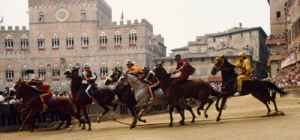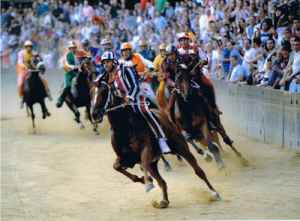- MENU
- HOME
- SEARCH
- WORLD
- MAIN
- AFRICA
- ASIA
- BALKANS
- EUROPE
- LATIN AMERICA
- MIDDLE EAST
- United Kingdom
- United States
- Argentina
- Australia
- Austria
- Benelux
- Brazil
- Canada
- China
- France
- Germany
- Greece
- Hungary
- India
- Indonesia
- Ireland
- Israel
- Italy
- Japan
- Korea
- Mexico
- New Zealand
- Pakistan
- Philippines
- Poland
- Russia
- South Africa
- Spain
- Taiwan
- Turkey
- USA
- BUSINESS
- WEALTH
- STOCKS
- TECH
- HEALTH
- LIFESTYLE
- ENTERTAINMENT
- SPORTS
- RSS
- iHaveNet.com: Vacation Travel
By Margaret M. Johnson

While Rome is Italy's "Eternal City," Venice its romantic city, and Florence "the cradle of civilization," Siena is best known as the city of the Palio.
The ancient event, held twice each summer on July 2 and August 16, is so important to Sienese history and society that residents are said "to measure time from one Palio to the next."
One of Italy's most famous festivals, the Palio is a frenetic, bareback horse race involving 10 contending contrade (various districts of the city).
It's deeply rooted in the medieval custom of celebrating the most important religious festivities with games, and in this case, the July 2 race (Palio di Provenzano), held since 1656, celebrates the Feast of the Visitation.
It's also the date of a local festival in honor of the Madonna of Provenzano who supposedly had miraculous healing powers. The second race (Palio dell'Assunta), added on Aug. 16, 1701, the day after the Feast of the Assumption, is also dedicated to the Virgin Mary. Some say it gives the Sienese "less time for measuring."
I dragged long-suffering hubby to the scorching event a few years ago -- more on the "scorching" part later -- to make up for all the freezing football games he dragged me to over the years, and when we revisited Siena on a rain-soaked day last June, I was reminded not only of the heat but of how exciting the event can be.
Here's what Palio, Italy is all about:
The race field consists of 10 horses, so not all 17 districts can take part in the Palio on any occasion.
The seven districts that didn't take part in the previous year's race are automatically included and three more are chosen by draw.
Private owners offer the pick of their stables, and some horses are selected after trial races in Siena and at other Palio races in other parts of Italy.
The event starts at about 7:30 p.m. with an explosion that signals to the onlookers that the race is about to begin.
The race runs for three laps around the shell-shaped Piazza del Campo, the city's main square, the outer course of which is covered with several inches of dirt, the corners of the square protected with padded crash barriers, and the inner space filled with spectators.
The jockeys ride the horses bareback from the starting line, an area between two ropes.
Nine horses, in an order only decided by lot immediately before the race starts, enter the space. The 10th, the rincorsa, waits outside. When the rincorsa finally enters the space between the ropes the starter activates a mechanism that instantly drops the front rope.
The race usually last no more than two minutes, and it's not uncommon to see jockeys being thrown off their horses while making the treacherous turns in the piazza.

The winner, awarded a banner of painted silk, or palio, is the first horse to cross the finish line with its head ornaments intact, and a horse can win even without its rider.
The loser in the race is considered to be the contrade whose horse finished second, not last.
The enthusiasm after the victory is so intense that the ceremony awarding the palio takes place almost as quickly as the race itself -- yes, about two minutes -- with victory celebrations beginning almost immediately and lasting for any number of days.
The two-minute race is the culmination of months of preparation on the part of each contrade, including neighborhood banquets held outdoors on the night before the race to celebrate the anticipated victory.
For visitors to Siena during this time, it's a great way to be immersed in local color and culture, and if you know the right people or book a tour that includes tickets to one of the neighborhood banquets, all the better!
An now to the "scorching."
A magnificent pageant, the Corteo Storico, precedes the race at about 4 p.m., and attracts visitors and spectators from around the world. Some of the pageantry includes troupes of alfieri (flag-wavers in colorful medieval costumes representing the various contrades), a squad of sword-wielding carabinieri (national police) on horseback, banners, antique floats, and horse- and ox-drawn carts.
Spectators who want the best position near the Mossa (the prime viewing area) -- including hubby and me and an estimated 50,000 more -- arrive early in the morning, noon at the latest, eventually filling the centre of the town square inside the track.
The summer temperature in Siena can rise to the high 90s, and with no seats, a limited number of vendors selling cold water, and no bathroom facilities in the center of the track, it is -- to say the least -- an experience!
The only relief for those who camp out in the center of the square is to mark your territory -- preferably near the outside fence -- and work in tandem for any kind of relief. The local police seal the entrances once the festivities begin in earnest, so planning ahead is imperative.
Seats ranging from simple bleachers to elaborate box seats on balconies are available, however, from local brokers or through a tour operator. Tickets range in price from 285 to 480 Euros, depending on location and proximity to the start/finish line. I was told that the landlords of buildings overlooking the piazza sometimes stipulate that tenants must be absent on the day of the Palio in order to rent the space to spectators!
So if you're planning a summer tour to Tuscany, you might want to schedule it around Palio time in Siena, either on your own, with a tour operator who arranges accommodations and a seat, or through Jacopo Della Torre, a Florentine who specializes in tickets to colorful spectacles like the Palio and the Festival San Fermin (running of the bulls) in Pamplona. His motto is "being there, but without the crowds," and for the Palio, Della Torre secures seats in balconies and in the grandstand. All seats are typically accessible 30 minutes prior to the start of the historical parade through the end of the race. Because of their variety and diversity of seating, Della Torre works directly with clients via his Website (www.jacopodellatorre.com).
TOUR OPERATORS
Palio Tours offers three- and four-night packages at several hotels and one-week apartment stays.
Each includes accommodations with breakfast, grandstand or balcony tickets, a contrade dinner, and city tour.
Prices are based on Euros and range from 645 to 990 per person. Visit www.paliotours.com or phone 888-495-8502.
Tuscany Tours offers nine different tours to the region from April to November, including "Best of Tuscany: Palio Time," June 28 to July 6.
In addition to accommodations in Siena, the eight-night package includes Florence and the Chianti area, most meals, wine tastings, and admissions to galleries and museums.
Participants are in Siena during the trial runs of the Palio but not on July 2.
All tours are limited to 14 participants; prices start at $3,390 per person based on double occupancy. Visit www.tuscanytours.com or phone 800-634-3460.
WHERE TO STAY
Grand Hotel Continental, Via Banchi di Sopra 85, is the only five-star hotel in Siena. Opened in 2002, the 51-room property is housed in the 17-century Palazzo Gori Panelini and contains many original architectural features, decorations, and frescoes. Some of the suites offer views of the Duomo; others have lofts. The Sapordivino wine bar and restaurant serves typical-but-elegant Tuscan cuisine, including ribollita (vegetable and bread soup), pappardelle (wide noodles) in hare sauce, and pici (thick, chewy spaghetti?) with garlic and tomato. Double rooms start at 355 Euros and include American-style breakfast. Phone +39 06 699811 or visit www.royaldemeure.com.
Hotel Garden, Via Custoza 2, a four building complex of 122 rooms and suites, is only a short walk from the city walls. The main building is a 19th-century residence with frescoed walls and antique furnishings; some rooms in the other buildings have views over the countryside, garden, tennis court, or pool. Double rooms start at 165 Euros; phone +39 0577 567111 or visit www.gardenhotel.it.
NH Excelsior, Piazza la Lizza, was originally Jolly Hotel Siena. Recently refurbished, its 129 rooms are decorated in a modern style, and the hotel features all the conveniences you'd expect in the NH chain of 345 hotels in 22 countries (bar, restaurant, gym). Its restaurant, Al Rastrello, offers traditional local specialties, grilled meats, pastas, and cheeses. Double rooms start at 125 Euros; phone +39 0577 382111 or visit www.nh-hotels.com.
VISITOR INFORMATION
For information on Italy, visit the Italian Government Tourist Board (ENIT) at www.italiantourism.com. The Agenzia per il Turismo (APT) office in Siena is at Piazza del Campo 56; the currency in Italy is the Euro. All phone numbers are for local calls; from the United States, dial 011+ 39+ 0577 plus local number.
© Margaret M. Johnson Distributed by Tribune Media Services, Inc.
Margaret M. Johnson has been writing about food and travel for more than 20 years. She is also the author of many Irish cookbooks, including "Irish Puddings, Tarts, Crumbles and Fools," a desserts cookbook published by Chronicle Books, San Francisco.
AFRICA TRAVEL | AMERICAS TRAVEL | EUROPE TRAVEL | 10 BEST in TRAVEL | FAMILY VACATIONS | AUTOS | HOBBIES | EDUCATION | FAMILY | FASHION | FOOD & RECIPES | HOME DECOR | RELATIONSHIPS | PARENTING | PETS | TRAVEL | WOMEN
Travel | Siena's Palio Sets Stage for Touring Tuscany - Travel Italy